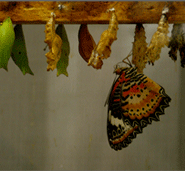This issue may not be true, but its definitely real. These existential questions of truth and reality are ones that trouble us most in our late teens, when we are being transformed most rapidly, both physiologically as well as psychologically. Truth was always deduced by a process of logic: If a is more than b and b is more c, then a is more than c. That is true, and therefore a kind of axiom. Then, as we grew older, we learnt about the 'paradoxes'. If a is a liar and claims that this sentence is false, is it true?
I asked a fellow writer this summer: why do we write fiction? He said he was going to climb a mountain and on his return he'd have an answer. A day and worn hiking boots later, he came down the mountain, lit a cigarette, shrugged his shoulders, "Because people like to lie and be lied to," he said.
Each of our four stories attempt to answer this question through their own lenses: Janice claims we write fiction because it makes us immortal, or saves us from death. In imagining stories that music evokes, Sahil Vasudeva posits that is invigorates our imaginations; Astha Butail, through fashion and fittings, displays the power of fiction to inspire curiosity and Kartik Sood's sister, Kriti, in retelling her childhood with a dreamer, exhibits how fiction allows us to make art. What all four hint at is Fiction's inherent propensity to Transform.
Most great (canonical) works of literature follow Aristotle's literary arc, in which a character, in his pride, makes an error of judgement, experiences a downfall and then resurrects himself through an inner realization of the 'truth'. At the end of the story, the character is left Transformed.
We live with fiction everyday. The stars appear to move across the night sky even as they are dying, or light years away. We delude ourselves about those we love. We hide our blemishes behind flimsy foils of laughter and distraction. We make up stories to make the ordinary extraordinary. And sometimes we make up stories to fill in the gaps of uncertainty and the instinctual invisibles that catch us off guard, the intangibles that science or math cannot grid, the unknowns that we can only sense and that language is too fickle to describe.
As the wise Iff tells young Haroun: "I am having time wasted by a Disconnector Thief who will not trust in what he can't see. How much have seen, eh, theiflet? Africa, have you seen it? No? Then is it truly there? And submarines? Huh? Also, hailstones, baseballs, pagodas? goldmines? kangaroos, Mount Fujiyama, the North Pole? And the past, did it happen? And the future, will it come? Believe in your own eyes and you'll get into a lot of trouble, hot water, a mess."
The issue on fiction toys with illusions, appearances, storytelling, dreams, the imagination and the ghosts of the written word. It attempts to open up the world of the made-up through literature, music, design and art, to expose the paradoxes that come with holding a mass of sand in your hand.
Don't believe everything, but believe in everything. If you're still navigating the lines between truth and reality, and realize everything you know is an utter lie and totally true, that everything is circular, you've been transformed, and you're free. You can die having become younger. That, is the paradox of paradoxes.
Fictitiously,
Himali.
Editor's Note.
Every sunbeam, every strain of music, every sapling and starfish is ultimately the regeneration of a previous something, a collection of somethings, taking on new shape. At the most indivisible level we can comprehend, all life is nothing more than atoms and molecules dancing their way through various forms. And if everything comes from something, it stands to reason that everything must go to something as well.
Read More
Illusion: Seeing Beyond Seeing
Meaning: In Search of Significance.
Melody: A Different Tune
Rhythm: Ordering Time


